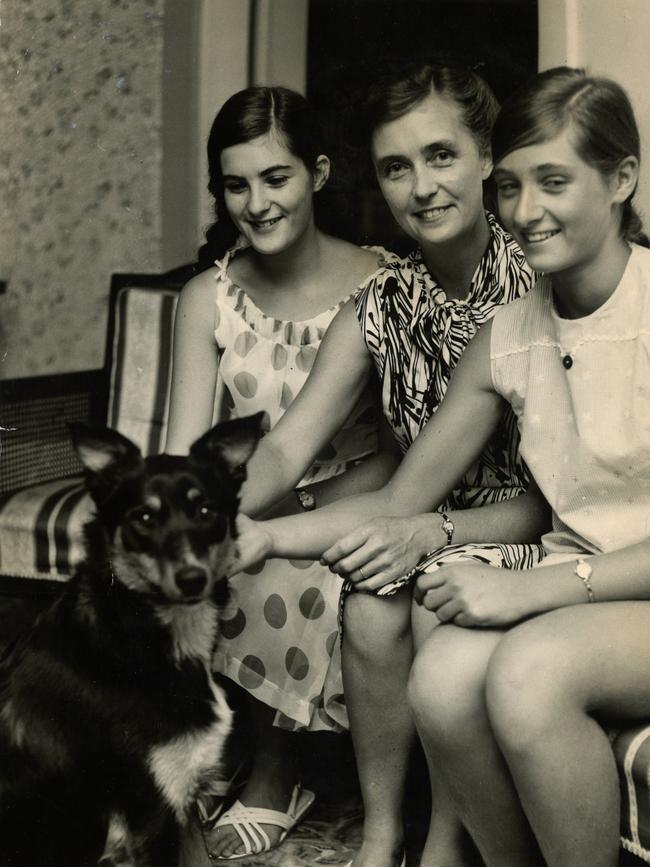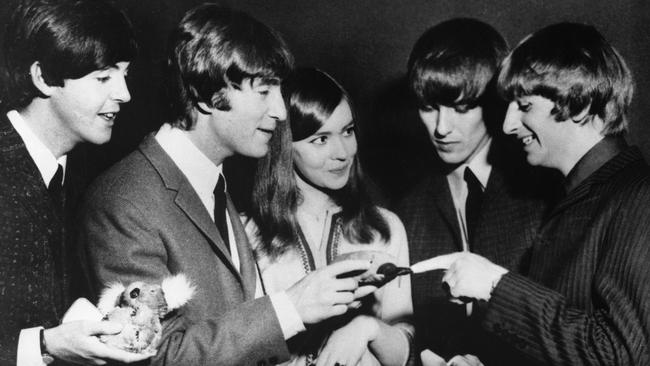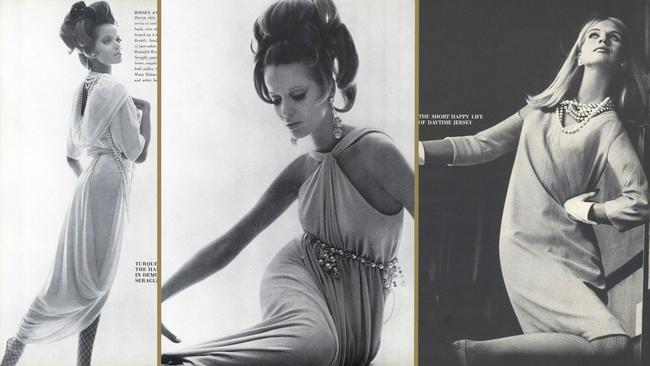Time when a woman could see ‘delicious new possibilities in her own allure’
The first woman to be appointed to a chair at Sydney University, Leonie Kramer, had a balance other women might have envied. When interviewed by The Australian in 1968, she had just enjoyed ‘a nice vacation making jams and preserves’.

For this masthead’s 60th anniversary, we are publishing the ways we reported on Carla Zampatti, a woman ‘having it all’, and Beatlemania.
Leonie Kramer, later a dame, set a high bar by succeeding in academia, keeping a clean ‘ménage’, and making preserves, according to our front page story of March 5, 1968. Yes, women could have it all.
A MOTHER AT THE TOP SAYS IT’S EASIER TO GET THERE NOW
- By Graham Williams. First published March 5, 1968
Professor Leonie Kramer, looking poised and elegant, said thoughtfully: “It certainly is easier for women to get to the top now – but the battle is by no means won.”
For Professor Kramer, though, the battle was won late yesterday in the Senate room of Sydney University. She broke a 118-year-old barrier by becoming the first woman to be appointed to a chair at the university – Australian Literature.
As she relaxed with her husband and two daughters in their magnificent Vaucluse home overlooking Sydney Harbor last night, she said her appointment might encourage other women.
“Once ne woman gets to the top, it gives others the confidence to aim high,” she said.

Blended roles
Professor Kramer, who has been associate professor of English at the University of NSW since 1963, is one of Australia’s outstanding English scholars.
Her husband, too, has reached the top. Dr H. Kramer is director of the Institute of Clinical Pathology and Medical Research, a State health agency in Sydney.
She blends the roles of academic, mother, wife and manager of an immaculate ménage with an ease and charm that would be envied by most women.
“Working mothers can succeed,” she said, “but you have to be prepared not to have too much time off. It is also largely a matter of temperament. My professional and home life balance each other – I love cooking and I’ve just had a nice vacation making jams and preserves.
“But I hesitate to say to women they should get out and work because a large number aren’t temperamentally suited to it.”
Professor Kramer, who graduated in Arts at Melbourne University with first-class honours in English and history, had her professional career interrupted after she had gained a doctorate in philosophy at Oxford in 1953. She had to take off two years while she cared for her two young children – Jocelyn, now 15, and Hilary, 14.
Her challenge
She returned to lecturing at the Canberra University College when Hilary was seven months old, leaving the children in the care of “a dear old Yorkshire lady” during the day. To her children she has always been a working mother. “I don’t think it’s done them much harm,” she said. “It’s made them a little more independent. But you have to be careful not to impose on them.”
Professor Kramer says that some of the most interesting Australian literature has been written in the past 20 years by people like Douglas Stewart, A.D. Hope, Judith Wright, Kenneth Slessor, Patrick White and Thomas Keneally.
Patrick White has probably had the greatest impact of any Australian writer, and also Morris West, though she sees West more as an international writer. White and Hope had done much to break down the provincial, insular nature of Australian writing.
On August 24, 1964, we gave space on page one to the global craze of Beatlemania, which had recently infected Australia
CALL FOR A BAN ON THE BEATLES
- First published August 24, 1964

The supervisor of Washington state’s child-guidance centres yesterday urged a ban on the Beatles and attacked parents for allowing children “a mad erotic world of their own”.
Bernard Saibel, who controls 23 guidance clinics, said that during the Beatles’ 30-minute stage show on Friday the crowd of 14,000 – mostly teenage girls – became “frantic, hostile, uncontrolled, unrecognisable human beings”.
An emergency first aid station in the Seattle Coliseum treated 35 cases of fainting, bruises and cuts and nervous sickness during the show. One youth fell 25 feet down an air shaft during the melee after the show.
“This is not simply a release,” Dr Saibel said. “It is a destructive process in which adults allow their children to be involved.”
He said the relentless, primitive beat of Beatle music released the newly acquired physical impulses of the teenager. With this is the phenomena of mass hypnosis, contagious hysteria and the blissful feeling of being involved in an all-embracing, orgiastic experience.
More than 170 police, firemen and servicemen were put on duty to quell the series of near riots.

A NEW KIND OF WOMAN
- Reflections on the era by Edwina McCann, editorial director of Vogue Australia
The 1960s were a revolutionary time for fashion; changes in society were almost perfectly encapsulated in what people wore.
The birth of modern-day feminism spurred women to dress on their own terms, which meant silhouettes with more androgynous, less constricting fits.
Designers including Andre Courreges, Pierre Cardin and Marc Bohan of Christian Dior took over fashion with their forward-facing visions of womenswear, which defied classically feminine silhouettes (nipped waistlines and big skirts, which were everywhere in the ’40s and ’50s), and instead became something the world had never seen.
Jacqueline Kennedy’s penchant for Chanel’s edgy tweeds caused a global fashion sensation, while Twiggy’s insouciant look and pixie haircut defined an era.
On home soil, supermodel Jean Shrimpton’s above-knee white shift dress at 1965’s Derby Day flew in the face of puritanical views about womenswear, and is now considered iconic.

In few places was this better communicated than in the fashion imagery of the
era. Photographers such as Richard Avedon, Irving Penn, Helmut Newton, Rubartelli and Bert Stern captured their muses with a new power and boldness, far from historically submissive depictions of femininity.
Stern and Rubartelli’s imagery for Vogue, which appeared in The Australian in 1965, shows models draped in pearls, mod suits and even trousers, A face you’ll notice is Veruschka, the era-defining model and Rubartelli muse known for her striking beauty, who frequented the cover of Vogue in the 1960s and would memorably visit Melbourne Fashion Festival in the 2000s.
The accompanying copy read that fashion like this could “make a woman see … delicious new possibilitie
s in her own allure”. It’s little wonder Stern was one of Marilyn Monroe’s favourite photographers, and worked consistently with the superstar until her death in 1962.

After the launch of Vogue Australia as a standalone magazine in 1959, Helmut New
ton shot some of its most famous ’60s covers, one involving a model in a swimsuit with a kangaroo for quintessential Australiana. These images have gone on to shape the legacy of powerful and distinct Australian fashion imagery, which continues in Vogue Australia and in Wish, the monthly style and culture liftout in The Australian.
In many ways the ’60s is a decade that shaped women’s agency in fashion for decades to come. They are also the decade that made women ask: if fashion can’t make you feel powerful, then what’s the point?
On July 18, 1967, a 25-year-old designer recalls selling her tiny first range out of a suitcase. Carla Zampatti had a long way to go.
HOW TO SUCCEED AT FASHION
- First published July 18, 1967
Fashion for the few stopped being the rule some time ago – thanks to London’s lead, and a handful of young and imaginative Australian designers who took a gamble to make a career out of something they really wanted to do.
One is Italian-born Carla Zampatti who had her first success at the age of 13 when she sent a swimsuit back to a manufacturer because the elastic had stretched and was useless.
She’d never liked the swimsuit’s design, anyway, and changed it soon after she bought it. But she wasn’t prepared for the manufacturer’s reaction to the change.
They sent her a new swimsuit and a polite note congratulating her on her “improvements in the design”.
Despite the encouragement, her fashion career didn’t get under way until several years later after her marriage to Dutch-born Leo Schuman, who has now given up his own business to work with Carla.
“He helped me financially at first – I didn’t make any profit for the first six months. Then little by little, my designs became more popular.
“I remember going round trying to sell my first range – it must have been the smallest collection any of the shops had ever seen. I think there were five outfits which I carried in a little suitcase.
“Luckily the owner of the first shop I went into ordered some from me, otherwise I don’t think I would have been brave enough to go any further.
“Leo decided to come into the business after a trip we took recently to Europe to see his parents. In Europe, he decided fashion was a lot more interesting than office partitioning – that’s the business he was in before – so now he handles production while I design and sell the clothes. It works very well. We’ve just opened our own factory. I used to do the designs, then contract other people to make them up – not a good way to do things.”

Carla, blonde with distinctive European good looks, is an ex-model and a fine advertisement for her clothes, which she designs to her own taste (“I designed commercially one year – things I didn’t necessarily like but thought people would buy – and I didn’t sell a thing”).
She works at home in her Sydney flat, standing in front of a mirror draping fabr
ics on herself. “I keep up with overseas magazines to get a feeling for the trends, but I find fabrics inspire me most. Some of them are so beautiful.
“I do four ranges a year … clients either come here to the flat or I take samples to them. I’d like to have a big show one day, but that will have to wait a while.”
Meanwhile, the current Zampatti trends? “This is the only time when I can remember almost every colour being fashionable _ bright electric pink, mauves, tonings of lime, green and citrus. But they’re not being used to contrasting effects but to tone with one another. And ponchos. I think we’ll be seeing more of them. They’re comfortable, colourful and very attractive.”

To join the conversation, please log in. Don't have an account? Register
Join the conversation, you are commenting as Logout